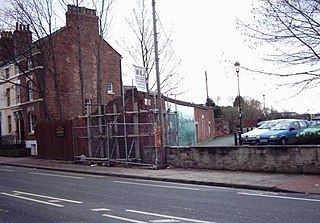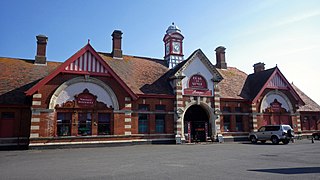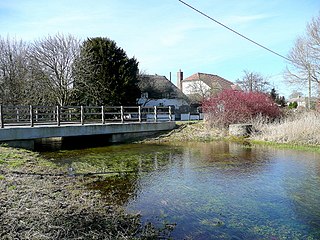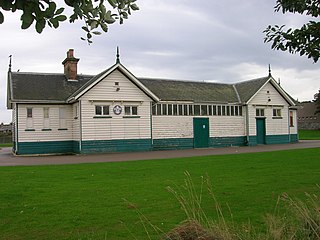
Central is a heritage-listed railway station located in the centre of Sydney, New South Wales, Australia. The station is the largest and busiest railway station in Australia and serves as a major transport interchange for NSW TrainLink inter-city rail services, Sydney Trains commuter rail services, Sydney light rail services, State Transit and private bus services, and private coach transport services. The station is also known as Sydney Terminal. The property was added to the New South Wales State Heritage Register on 2 April 1999. It recorded 85.4 million passenger movements in 2018.

Dawlish Warren railway station serves the seaside resort and holiday camps of Dawlish Warren in Devon, England, at the mouth of the River Exe. The station is on the Exeter to Plymouth line, 10 miles 42 chains (16.9 km) down the line from Exeter St Davids and 204 miles 34 chains (329.0 km) measured from London Paddington via Bristol Temple Meads.

Salisbury railway station serves the city of Salisbury in Wiltshire, England. It is 83 miles 43 chains (134.4 km) from London Waterloo on the West of England line to Exeter St Davids. This is crossed at Salisbury by the Wessex Main Line from Bristol Temple Meads to Southampton Central. In the past timetabled routes had more distant destinations to the south-west including Ilfracombe, Padstow and Plymouth. The station is operated by South Western Railway (SWR) and also served by Great Western Railway (GWR).

Allington is a village and civil parish in Wiltshire, England, about 3 miles (5 km) southeast of Amesbury and 7 miles (11 km) northeast of Salisbury. The parish includes the village of Boscombe; both villages are on the River Bourne and the A338 road. Most of the west boundary of the parish is also the county boundary with Hampshire.

Bulford is a village and civil parish in Wiltshire, England, close to Salisbury Plain. The village is close to Durrington and about 1.5 miles (2.4 km) north of the town of Amesbury. The Bulford Camp army base is separate from the village but within the parish.

Southampton Terminus railway station served the Port of Southampton and Southampton City Centre, England from 1839 until 1966. The station was authorised on 25 July 1834 and built as the terminus of the London and Southampton Railway, which later changed its name to the London and South Western Railway (LSWR). The station opened as "Southampton" on 10 June 1839, although it was not officially operational until 11 May 1840, due to the track not being fully linked between Winchester and Basingstoke.

The Devon and Somerset Railway (D&SR) was a cross-country line that connected Barnstaple in Devon, England, to the network of the Bristol and Exeter Railway (B&ER) near Taunton. It was opened in stages between 1871 and 1873 and closed in 1966. It served a mostly rural area although it carried some through services from east of Taunton to the seaside resort of Ilfracombe.

Shrewsbury Abbey was a railway station in Shrewsbury, Shropshire, England part of the Shropshire and Montgomeryshire Railway. It was named after the nearby Shrewsbury Abbey. The station had an adjacent goods yard and wagon building works.

Bulford Camp is a military camp on Salisbury Plain in Wiltshire, England. Established in 1897, the site continues in use as a large British Army base. The camp is close to the village of Bulford and is about 2+1⁄4 miles (3.6 km) northeast of the town of Amesbury. The camp forms part of the Tidworth, Netheravon and Bulford (TidNBul) Garrison.

Marlborough railway stations refers to the two railway stations which served Marlborough, Wiltshire, England; the town supported two railway routes and Savernake, the junction station at first, later had a second station.

Amesbury railway station was a station in the county of Wiltshire in southern England. It was located on the Bulford Camp branch line, which diverged from what is now known as the West of England Main Line at a triangular junction between Grateley and Idmiston Halt. When it was open, Amesbury was the nearest station to Stonehenge and carried a lot of traffic to the military areas in and around Salisbury Plain, particularly during the Second World War in the preparations for D-Day.
The Salisbury branch line of the Great Western Railway from Westbury to Salisbury in Wiltshire, England, was completed in 1856. Most of the smaller stations were closed in 1955 but the line remains in use as part of the Wessex Main Line.

Bexhill West is a closed station in Bexhill-on-Sea in East Sussex. It was the terminus of the Bexhill West branch of the Hastings Line. It was opened by the South Eastern and Chatham Railway and was operated by the Southern Region of British Railways on closing. The station building still survives as an antiques house. The trackbed and site of the now demolished platforms are now occupied by commercial industrial buildings.
The Amesbury and Military Camp Light Railway was a branch line in Wiltshire, England, constructed under a light railway order dated 24 September 1898. It was opened for military traffic from Amesbury to the east-facing Newton Tony Junction on 1 October 1901. A west-facing junction, Amesbury Junction, where the branch burrowed under the main line, opened on 2 June 1902. The line closed in 1963.
The Stert and Westbury Railway was opened by the Great Western Railway Company in 1900 in Wiltshire, England. It shortened the distance between London Paddington station and Weymouth, and since 1906 has also formed part of the Reading to Taunton line for a shorter journey from London to Penzance.

Newton Tony is a rural English village and civil parish in the county of Wiltshire, close to the border with Hampshire. Situated in the Bourne Valley, Newton Tony is about 9 miles (14 km) north-east of its post town, Salisbury. It is the site of Wilbury House, a 17th-century mansion designed by William Benson.

Longmoor Downs railway station is a former railway station, on the Longmoor Military Railway serving Longmoor Military Camp. The station was the Southern terminus of the original standard gauge railway opened in stages between 1907 and 1908.

Portsoy railway station was a railway station in Portsoy, in current day Aberdeenshire. Opened in 1859 by the Banff, Portsoy and Strathisla Railway, it was absorbed by the Great North of Scotland Railway in 1867. The original terminus closed in 1884 and a new station opened nearby on a through route and two years later, after the Moray Firth coast line opened, the station was served by Aberdeen to Elgin trains.

Dinton railway station is a disused railway station which formerly served Dinton in Wiltshire, England. It was situated on the West of England Main Line from London Waterloo station to Exeter. It was opened in 1859 and closed to passengers in 1966 and to general goods traffic in 1967. In the First World War, it was the junction for the Fovant Military Railway. The station was about ½ mile from the centre of the village.
Lofthouse-in-Nidderdale railway station was the northernmost regular passenger terminus on the Nidd Valley Light Railway (NVLR), in Lofthouse, then in the West Riding of Yorkshire and now in North Yorkshire, England. The station was built as part of Bradford Corporation's programme of reservoir building in the Upper Nidd Valley. The station opened in 1904 and was closed to passengers in 1930. The station was renamed Lofthouse-in-Nidderdale railway station in 1907 to avoid confusion with Lofthouse and Outwood railway station, also in the West Riding of Yorkshire.
















